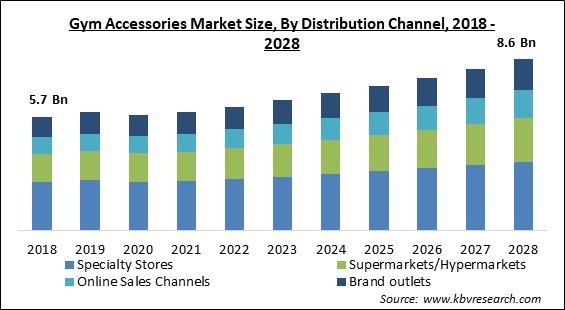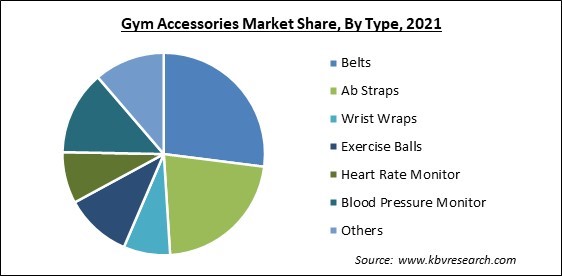The Global Gym Accessories Market size is expected to reach $8.6 billion by 2028, rising at a market growth of 5.6% CAGR during the forecast period.
The term gym accessories refer to a variety of specialized support items used in physical activities such as athletics, workouts, or bodybuilding to improve performance during and speed up recuperation thereafter. It also includes items used for entertainment, nourishment, and refreshments during workouts. These items are used when exercising to support the body and maintain ideal forms and angles in order to lessen hyperextensions, muscle stress, and exhaustion of the muscles and joints.

The most popular support accessory types are belts, wraps, straps, supports, and performance monitors. Other accessories, including sippers, towels, mats, music players, and more, are utilized afterward during the recovery or leisure phase. Some of the most popular types of gym accessories are those that are designed to support certain body parts, such as the wrists, arms, waist, back, and spine. While performing demanding workouts like weightlifting or deadlifting, the constrictions in the muscles & tightening of the areas of support assist the customer to conserve energy and maintain the proper angles and posture.
They also lessen muscle strain, which helps to prevent injuries and post-workout tiredness. Consumers' involvement in health & fitness activities has significantly increased in recent years, particularly in the wake of the pandemic. Many customers participate in these activities because they want to be active and live a healthy lifestyle, while others do so because of work obligations. The bulk of gym accessory buyers is professional bodybuilders, models, actors, and numerous social media celebrities that are involved in the fitness industry.
They utilize these products mostly because they need to be careful about how much they exercise and how they exercise because little errors could result in injuries. Gym accessories that offer support and form correction assist in preventing such errors. By wiping off the surplus sweat, other accessories such as towels and wipes assist the user feel revived after the activity
Earlier, home exercise was a practice reserved for beginners. However, current events have forced everyone to undertake workouts at home using a variety of accessories that are both financially and spatially manageable. Moreover, due to the pandemic, people are now more aware of health issues and obesity, which has increased the demand for gym accessories. Due to the outbreak of COVID-19, some testing laboratories were granted the ability but were constrained to adhere to social segregation and had less material and staff available. This boost in sales is anticipated to continue in the post-COVID-19 scenario due to the pandemic's pervasive effect on consumers' attitudes regarding health and wellbeing.
Young people, fitness experts, and athletes are becoming more and more interested in strength training machines in the gym equipment market. Strength training improves insulin sensitivity, cardiovascular stability, bone strength, and neuromuscular growth. The need for strength training equipment is rising as a result of rising health awareness and the incidence of lifestyle disorders like obesity, diabetes, obesity, and cancer among adults. The need for strength training equipment is rising as consumer awareness of health issues grows. Demand for high-quality, easy-to-install home workout equipment will rise as the virtual fitness industry expands.

In order to produce less complex and user-friendly devices that will enhance the complete consumer experience, equipment manufacturers are also highly investing in research and development (R&D) activities. Governments in developed, as well as emerging nations, are putting forth various healthcare initiatives to increase public awareness of fitness-related issues, which is also assisting in the acceptability of these accessories, particularly among young people. The market is anticipated to grow even further as a result of additional reasons like rising consumer buying power, the development of wearable technology that may connect to fitness equipment, and the availability of effective online shopping channels.
As going to the gym results in intense exercise, which typically increases the urge to eat more and more. It becomes more challenging for people to resist the cravings and attraction to eat, especially junk food because it makes them feel fuller faster. This causes a disruption in the diet because, depending on the final result of the workout, one is required to consume a specific quantity and type of food. It goes without saying that joining a gym is not an easy experience because one has to push themselves beyond the physical limits and step outside of the comfort zone.
By end user, the gym accessories market is classified into home; apartment; health club/gym; hotel; corporate office; and public institution, hospitals & medical center. The home segment acquired a significant revenue share in the gym accessories market in 2021. Due to their busy schedules, millennials and the elderly are adopting healthy habits and choosing to exercise at home. In addition, women in developing nations exercise regularly at home to preserve their physical well-being and physique. The demand for home gym equipment is being driven by these trends and thus, market in this segment is expected to expand.
On the basis of distribution channel, the gym accessories market is divided into supermarkets and hypermarkets, specialty stores, online sales channels and brand outlets. In 2021, supermarkets/hypermarkets segment generated a substantial revenue share in the gym accessories market. This is because of wide range of products available in supermarkets/ hypermarkets. Also, supermarkets are widespread over almost all the local areas near the houses of consumers. The ease of buying any product these supermarkets/ hypermarkets offer, the sale for gym accessories in this segment is rising gradually.
Based on type, the gym accessories market is segmented into ab straps, belts, wrist wraps, heart rate monitor, blood pressure monitor, exercise balls and others. The blood pressure monitor segment covered a substantial revenue share in the gym accessories market in 2021. Using a sphygmomanometer, often known as a blood pressure monitor, blood pressure is measured. It consists of a monitoring device that gauges the pressure inside the inflatable cuff that is put around the arm, roughly level with the heart. Systolic and diastolic pressures are measured by the monitor.
| Report Attribute | Details |
|---|---|
| Market size value in 2021 | USD 5.9 Billion |
| Market size forecast in 2028 | USD 8.6 Billion |
| Base Year | 2021 |
| Historical Period | 2018 to 2020 |
| Forecast Period | 2022 to 2028 |
| Revenue Growth Rate | CAGR of 5.6% from 2022 to 2028 |
| Number of Pages | 241 |
| Number of Tables | 430 |
| Report coverage | Market Trends, Revenue Estimation and Forecast, Segmentation Analysis, Regional and Country Breakdown, Companies Strategic Developments, Company Profiling |
| Segments covered | Type, Distribution Channel, End User, Region |
| Country scope | US, Canada, Mexico, Germany, UK, France, Russia, Spain, Italy, China, Japan, India, South Korea, Singapore, Malaysia, Brazil, Argentina, UAE, Saudi Arabia, South Africa, Nigeria |
| Growth Drivers |
|
| Restraints |
|
Region wise, the gym accessories market is analyzed across North America, Europe, Asia Pacific and LAMEA. The Asia-Pacific region led the gym accessories market with the highest revenue share in 2021. Some of the main contributors in the region are Japan, China, Australia, India, and South Korea. Due to the increase in weight reduction services and the significant interest in personalized training regimens, there is a greater demand for personal trainers and fitness instructors. There is an increasing need for trainers with a specialized understanding of safe and efficient fitness routines for senior persons as baby boomers actively focus on their health.
Free Valuable Insights: Global Gym Accessories Market size to reach USD 8.6 Billion by 2028
The market research report covers the analysis of key stake holders of the market. Key companies profiled in the report include ANTA Sports Products Limited, Core Health & Fitness, LLC, Life Fitness, Coulter Ventures, LLC (Rogue Fitness), Eleiko Group AB, Concept2, Inc., iFIT Inc., JERAI Fitness Pvt Ltd., Hammer Sport AG, and Body Solid Incorporated.
By Type
By Distribution Channel
By End User
By Geography
The Gym Accessories Market size is projected to reach USD 8.6 billion by 2028.
Strength Training Is Becoming An Evolving Trend are driving the market in coming years, however, Imbalanced Diet Of Individuals restraints the growth of the market.
ANTA Sports Products Limited, Core Health & Fitness, LLC, Life Fitness, Coulter Ventures, LLC (Rogue Fitness), Eleiko Group AB, Concept2, Inc., iFIT Inc., JERAI Fitness Pvt Ltd., Hammer Sport AG, and Body Solid Incorporated.
The expected CAGR of the Gym Accessories Market is 5.6% from 2022 to 2028.
The Belts segment acquired maximum revenue share in the Global Gym Accessories Market by Type in 2021 thereby, achieving a market value of $2.1 billion by 2028.
The Asia Pacific market dominated the Global Gym Accessories Market by Region in 2021, and would continue to be a dominant market till 2028; thereby, achieving a market value of $3.2 billion by 2028.
Our team of dedicated experts can provide you with attractive expansion opportunities for your business.

